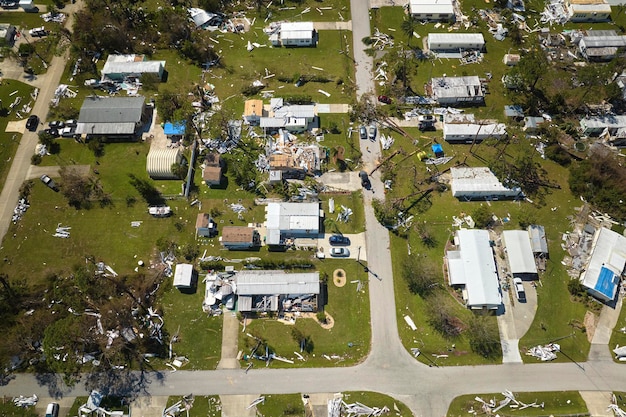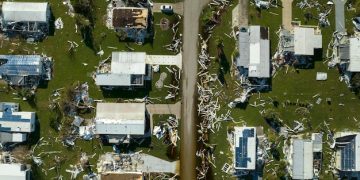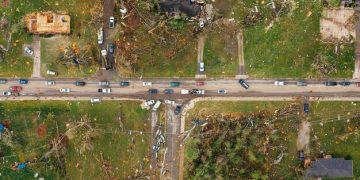Post-Disaster Recovery in the US: A Comprehensive Guide

Post-disaster recovery in the US involves a multifaceted approach encompassing immediate relief, infrastructure restoration, community rebuilding, and long-term resilience measures to help affected areas return to normalcy.
The aftermath of a disaster can leave communities devastated, facing immense challenges in rebuilding their lives and infrastructure. Post-disaster recovery in the US requires a coordinated effort from government agencies, non-profit organizations, and the affected communities themselves.
Understanding the Phases of Post-Disaster Recovery
Post-disaster recovery is not a singular event but a series of phases, each with its specific needs and priorities. Recognizing these phases is crucial for effective planning and resource allocation.
Immediate Response Phase
The immediate response phase, often referred to as the emergency phase, focuses on saving lives and providing essential needs. This includes search and rescue operations, medical assistance, and providing food, water, and shelter to survivors.
Short-Term Recovery Phase
The short-term recovery phase begins as the immediate threats subside. This phase involves clearing debris, restoring essential services like power and water, and providing temporary housing.
- Clearing debris from roads and properties.
- Restoring power and water services.
- Setting up temporary housing solutions.
- Providing mental health support to affected individuals.
This phase aims to stabilize the situation and provide a sense of normalcy as quickly as possible.

Assessing the Damage and Needs After a Disaster
A thorough assessment of the damage and needs is essential to guide the recovery efforts. This assessment helps identify the extent of the destruction, the resources required, and the priorities for rebuilding.
This includes identifying the number of homes destroyed, the damage to critical infrastructure, and the social and economic impacts on the community.
Infrastructure Assessment
Assessing the damage to infrastructure is critical for restoring essential services. This includes evaluating the condition of roads, bridges, power grids, water systems, and communication networks.
Social and Economic Impact Assessment
Understanding the social and economic impacts of the disaster is crucial for developing targeted recovery strategies. This includes assessing the impact on employment, businesses, schools, and healthcare facilities.
Without a comprehensive assessment, recovery efforts can be misdirected, leading to inefficiencies and delays.
Funding and Resources for Post-Disaster Recovery
Securing adequate funding and resources is vital for successful post-disaster recovery. This involves accessing federal, state, and local government funds, as well as private donations and insurance payouts.
Navigating the complex landscape of funding options can be challenging, requiring expertise and coordination.
Federal Disaster Assistance
The Federal Emergency Management Agency (FEMA) provides various forms of disaster assistance, including grants for individuals and families, funding for public infrastructure repairs, and technical assistance for state and local governments.
State and Local Funding
State and local governments also play a significant role in funding disaster recovery efforts. They may provide matching funds for federal grants, offer additional assistance programs, and leverage their own resources to support rebuilding efforts.

Community Engagement and Participation in Recovery
Engaging the affected community in the recovery process is essential for ensuring that their needs and priorities are addressed. This involves establishing communication channels, creating opportunities for participation, and empowering residents to take ownership of the recovery efforts.
Community-led recovery initiatives are more sustainable and effective in the long run.
- Establishing communication channels to keep residents informed.
- Creating opportunities for residents to participate in planning and decision-making.
- Empowering residents to lead recovery projects and initiatives.
This ensures that the recovery process is inclusive and responsive to the unique needs of each community.
Long-Term Strategies for Building Community Resilience
Building long-term community resilience is crucial for reducing the impact of future disasters. This involves implementing strategies to strengthen infrastructure, improve emergency preparedness, and promote economic diversification.
Resilient communities are better equipped to withstand and recover from future shocks.
Strengthening Infrastructure
Investing in resilient infrastructure can reduce the vulnerability of communities to disasters. This includes upgrading building codes, reinforcing bridges and roads, and developing redundant power and water systems.
Emergency Preparedness
Improving emergency preparedness can save lives and minimize damage during a disaster. This includes developing evacuation plans, conducting drills, and stockpiling essential supplies.
Navigating Insurance Claims and Legal Challenges
Post-disaster recovery often involves navigating complex insurance claims and legal challenges. Understanding your rights and responsibilities is crucial for receiving fair compensation and avoiding disputes.
Seeking legal assistance can be beneficial in resolving complex insurance claims and navigating legal processes.
- Documenting damage thoroughly with photos and videos.
- Understanding your insurance policy coverage and limitations.
- Meeting deadlines for filing claims and appeals.
The Role of Technology in Disaster Recovery
Technology plays an increasingly important role in disaster recovery, from enhancing communication and coordination to improving damage assessment and resource allocation.
Leveraging technology can streamline recovery efforts and enhance the effectiveness of response teams.
Communication and Coordination
Technology enables better communication and coordination among responders, government agencies, and affected communities. This includes using social media, mobile apps, and emergency alert systems to disseminate information and coordinate relief efforts.
Damage Assessment
Drones, satellite imagery, and other technologies can be used to assess damage quickly and accurately. This information can help prioritize recovery efforts and allocate resources effectively.
| Key Point | Brief Description |
|---|---|
| 🏠 Immediate Housing | Providing rapid temporary shelter to displaced residents |
| 💰 Funding Access | Securing federal and state aid, plus private donations for aid |
| 🤝 Community Support | Getting community involved in projects and planning |
| 🛡️ Infrastructure Boost | Investing in upgraded, long-lasting infrastructure |
Frequently Asked Questions
▼
The initial step involves immediate response efforts, focusing on saving lives, providing medical assistance, and ensuring basic needs like food, water, and shelter are met. This phase is critical for stabilizing the situation.
▼
You can access federal assistance through FEMA. Apply online or visit a disaster recovery center to understand eligibility criteria, required documents, and the types of aid available, such as housing assistance and grants.
▼
Community engagement ensures that recovery efforts align with the residents’ priorities and needs. Local knowledge helps create effective, inclusive, and sustainable solutions, promoting a sense of ownership and resilience.
▼
Insurance plays a vital role by providing financial resources to rebuild and repair damaged properties. Understanding your policy coverage and filing claims promptly are essential steps in securing the necessary funds for recovery.
▼
Technologies like drones and satellite imagery provide quick and accurate damage assessments, helping prioritize recovery efforts and allocate resources efficiently. Communication tools also improve rescue coordination and community information dissemination.
Conclusion
Post-disaster recovery is a complex and challenging process that requires a coordinated effort from government agencies, non-profit organizations, and affected communities. By understanding the phases of recovery, assessing the damage and needs, securing adequate funding and resources, engaging the community, and building long-term resilience, we can help communities rebuild and thrive after a disaster.





